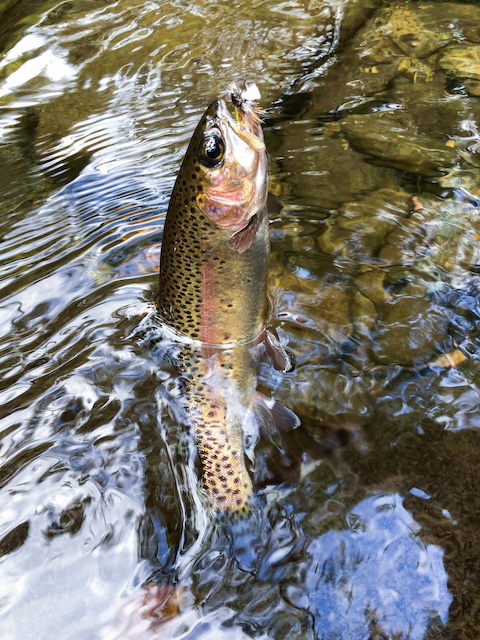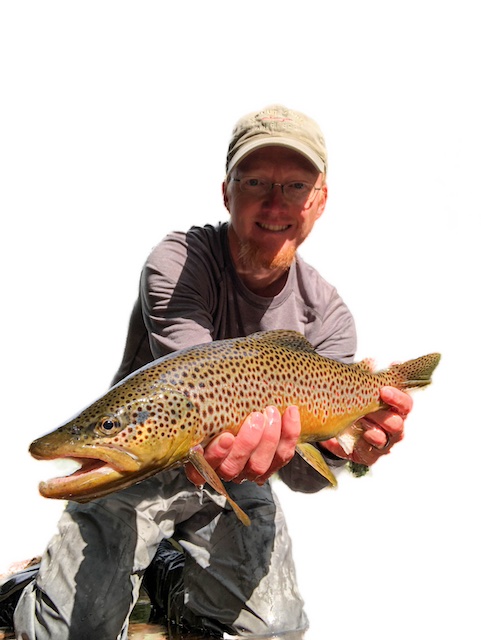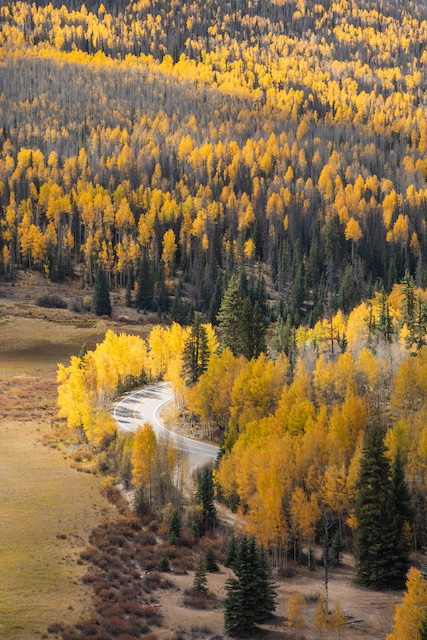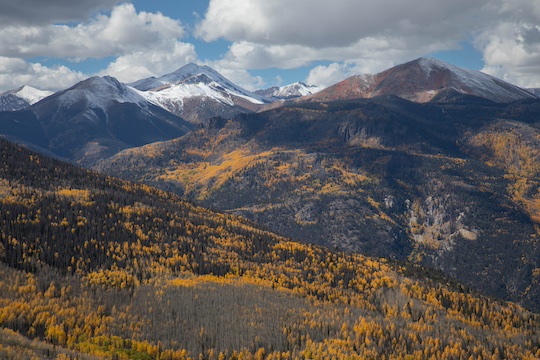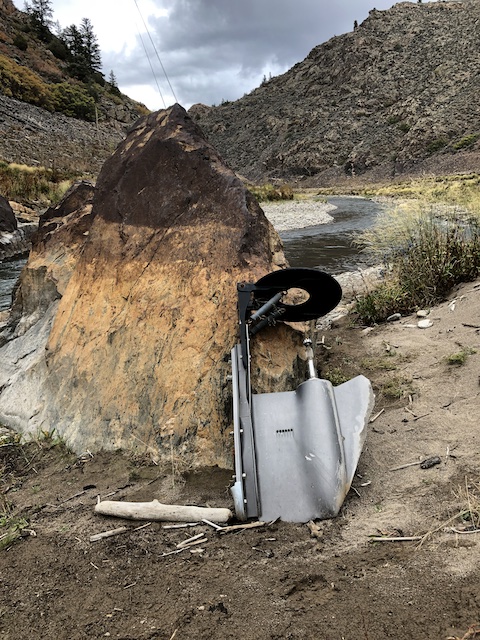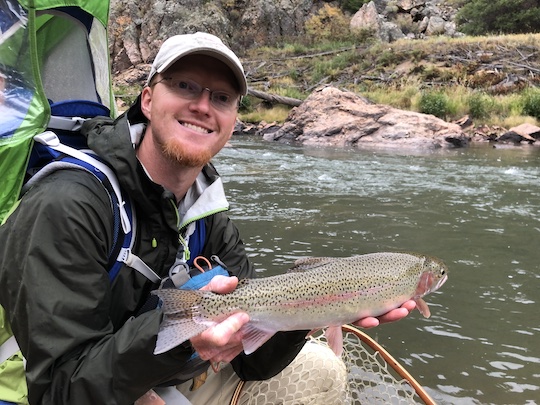Some trips are spontaneous, but most are the result of plenty of planning. After the last solar eclipse I experienced all the way back in 2017, I knew that any and all solar eclipses in the future would require my best effort to see them. In 2017, I had the luxury of having the path of totality crossing my home county. We enjoyed the show without much effort, but the awe inducing experience convinced me that it was worth almost any amount of effort to see again.
Fast forward to 2023 and my life looks just a little different. I'm still a fly fishing guide, but now I'm married, have a kid, and any trip plans have to be made well in advance or else my guide calendar is full. When I saw that a solar eclipse was on the calendar for early April of 2024, I immediately started making plans. With my lovely wife on board, we decided to visit Arkansas. Since I had never fished the White River, a trip to Mountain Home or vicinity seemed in order. Time to see the eclipse and fish the White all in one trip...it doesn't get any better!
As the day for departure approached, I started getting everything ready that I could. Fishing gear was checked and checked again. Tents were dug out of the gear closet along with sleeping pads, bags, camp cookstoves, oh, and of course camera gear for the eclipse. Our first night's camping reservation started on Sunday, April 7. As things have become with a toddler in our lives, we didn't leave Crossville until MUCH later than ideal.
At least a little of this also had to do with booking myself right up to our trip. I keep telling myself to block a day or two off before and after each trip, but so far I keep falling for the same mistake of working right up until vacation starts. I spent all Sunday morning packing the car while my wife wrangled the little one. Finally, we more or less had everything ready to go. Off we headed on our big adventure, excited to see what fun we could have.
Not far down the road, we realized that in all the excitement, lunch time had snuck up on us. Pre toddler, we probably would have either just snacked or grabbed something and kept driving, but having a little one changes how you do things. A longer than necessary stop ensued 45 minutes into our trip. The silver lining was that a full belly and nap time provided us with an hour or so of quiet.
Eventually, after many changed diapers and pit stops, we finally made it to our campsite in the middle of the night. Okay, it was probably actually around 10:00 pm, but it felt like 3 am. Thankfully, with the big eclipse the next day, we could sleep in, relax, and otherwise take it easy.
The question surrounding the eclipse was all about whether we would be able to see it. During the 2017 eclipse, some very last minute racing around the country side got us into position to see totality. With lots of large cumulus clouds around, it almost didn't happen. Home court advantage served us well on that adventure because we knew exactly where to go. For our Arkansas adventure and 2024 eclipse, we really needed good weather. By some miracle or stroke of good fortune, we had bright, sunny skies. Much of Arkansas was cloudy on April 8, but the area we had travelled to was blessed with low humidity and minimal cloud cover.
Around lunch time, the eclipse started. Little Bit was more interested in playing away on the playground next to our campsite, but I relished the opportunity to enjoy yet another eclipse. This time, I had better camera gear than I did the last time around. Of course, you always want something better, but I was happy with how my pictures of totality turned out. Here are just a few.
 |
| ©2024 David Knapp Photography |
 |
| ©2024 David Knapp Photography |
 |
| ©2024 David Knapp Photography |
Of course, no trip to Bull Shoals would be complete without fly fishing the legendary White River. Large predatory brown trout are what the White River is especially noted for, and I hoped to connect with a few. A friend and client of mine had recommended guide Taylor Wooten of Flippin Fly Guides. I decided that instead of dragging my own boat out or trying to wade fish, it would make a LOT more sense to fish with a guide who knew the river, had the right kind of boat, and could put me on fish. As a guide myself, I know that guides have a better pulse on their home waters than just about anyone else and generally know the best way to catch fish at any given time.
Monday afternoon, Taylor and I chatted on the phone to formulate a game plan, and then he texted me with a meeting spot for the next morning. We would be fishing where almost all the other guides were fishing which was on the Norfork River with perhaps a little time spent on the White near the confluence with the Norfork. There was a reason the guides were all on the Norfork. The fishing there was on fire compared to the White. As with most any fishing location, flows drive fishing choices on the White River system. The big river had been tough with seasonally low flows, but the Norfork was running just the right amount of water for great fishing.
Taylor was about as gracious as any guide I've met. He knew I really wanted to fish the White, so we kicked around a little there after meeting up Tuesday morning. Even better, he put me on several big brown trout. I always half joke with people that I'm a better guide than angler, and the results that day proved why it is only a halfway joke. I missed several big fish including one that I would really like to have back. But, I finally connected on my first White River brown which taped out at 19". From there, the trip just got better and better.
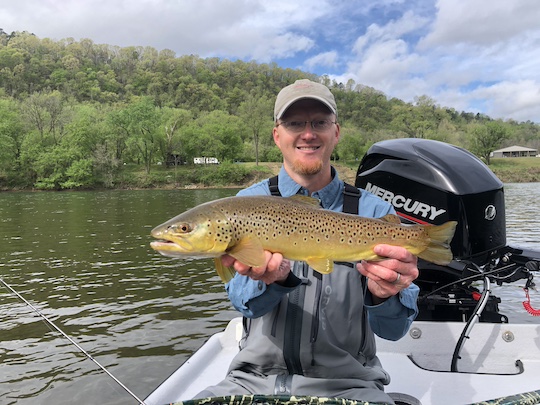 |
| Photo Courtesy of Taylor Wooten ©2024 |
After we kicked around on the White for a short time, we motored up the Norfork. Taylor graciously took me all the way up to the dam so I could see it and get some pictures. The rest of the day was a mix of nymphing and streamer fishing. I was glad to catch some nice strong rainbows that pulled as well as any I've caught. Eventually, the water started dropping out and we started heading back down the river. A few more nice brown trout interacted with my streamer but I never could seal the deal.
 |
| Photo Courtesy of Taylor Wooten ©2024 |
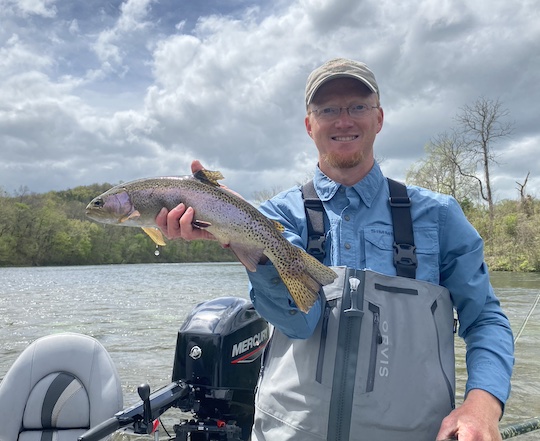 |
Photo Courtesy of Taylor Wooten ©2024
|
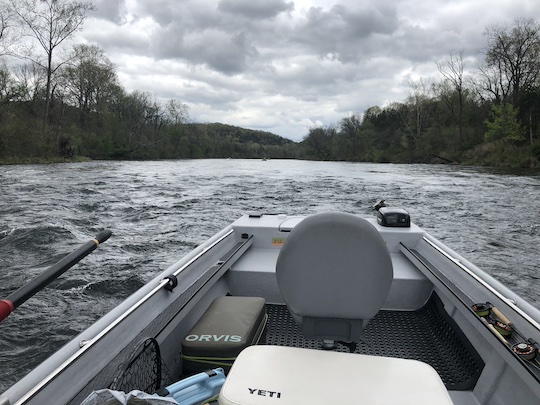 |
©2024 David Knapp Photography
|
|
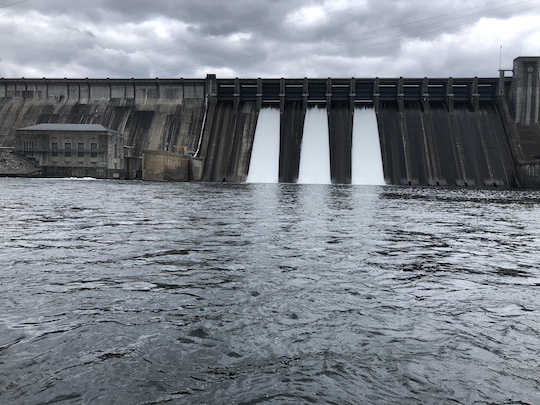 |
©2024 David Knapp Photography
|
|
As we slid into the takeout ramp, we checked the forecast for both weather and flows the next day. Things were looking wet, but there was a small bump of water in the morning on the White. Taylor graciously agreed to take me up to Bull Shoals dam the next morning even though he assured me that fishing hadn't been great up there as of late. I wasn't as worried about good fishing as most clients and more just wanted to see that part of the river system.
The next morning, the day dawned cloudy and dark. The threat of rain seemed very real and I was prepared for the worst. When we launched, a quick run up the river got us to the base of Bull Shoals dam, or at least as close as you are allowed to get. One thing that was interesting to me was that you weren't supposed to approach too closely to the dam. Here in Tennessee, we regularly get right up to the base of the dam on the Caney Fork River to fish the outflow from the turbines. However, there were very prominent signs everywhere prohibiting boaters from approaching the dam too closely. We went right up to the line and then started floating back down.
 |
©2024 David Knapp Photography
|
|
Streamers were the plan for the day. I still don't know how my arm held up, but I tossed my 8 weight Echo Streamer X (an absolutely incredible line of rods designed specifically for streamer fishing) almost the entire day. Taylor had some secret flies and we were ready to hunt. While I had a couple of half hearted follows up near the dam, Taylor was 100% accurate in his assessment of the current fishing up near the dam. It was pretty slow. While the temptation was strong to just hang around and fish that area regardless of the success rates, we started drifting on down the river.
Before long, we got side tracked. More accurately, Taylor let me side track us. We saw several pods of midging fish in a backwater, and I got excited. Midge fishing is just my game, so we stopped for a bit while I rigged up something for these fish. After a few stocker rainbows, it was apparent that I would get pulled in deeper and deeper by the occasional monster cruising around. If we wanted to stick to our plans, we needed to make a move and keep on streamer fishing.
Another move down river was in order, and before long, I was slinging the streamer rod again. The midge fishing interlude was just what I needed to get me going. As we approached a big shoal, Taylor gave me some directions as well as info about the water we were about to cover.
As the boat drifted down the bank, he started to point me to specific structure to target. The first good log produced a very large brown that I straight up missed. There were several fish that ate the streamer that I missed on this trip, and this was one of the better ones. Taylor saw that I was going to stew about missing the fish instead of getting back in the game and quickly pointed out the next log. I slung the fly and gave a strip. What happened next was one of the coolest eats I have ever seen on a streamer.
A large brown trout came up and rolled all the way over the top of the streamer. From the casting deck on Taylor's Supreme, it was easy for me to see the whole thing unfold. The fish missed the fly entirely on the first pass and by some miracle I didn't pull the fly out of the strike zone. The fish came down, swam downstream right on the bottom of the river, and after getting below the fly, came up to attack it again. This time, it nailed the fly and I got a legit strip set. We were off to the races and soon had the big brown trout in the net. After pulling over and getting pictures, it was time to try again.
 |
| Photo Courtesy of Taylor Wooten ©2024 |
 |
| Photo Courtesy of Taylor Wooten ©2024 |
We moved another fish or two, but it became apparent that the water was dropping out. Taylor made the decision to start a series of big moves down river. Each move was made with the goal of reaching another shoal that had good flow and lots of structure that the brown trout liked to hide in. Each shoal also had lots of fish. I continued to have some opportunities, some larger than others, but the second big fish was eluding me.
Finally, it all came together again in a particularly fast piece of water where a strong run swept tight to the right bank. This was another very nice fish over 20" with absolutely beautiful dark pumpkin colors.
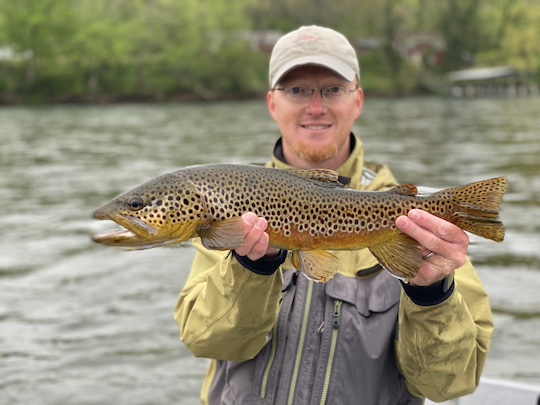 |
| Photo Courtesy of Taylor Wooten ©2024 |
From there, we kept moving down the river and hitting different spots all the way to Cotter. Amazingly, one of the coolest fish happened right above a particularly famous and picturesque bridge that is recognizable to many people who love the White. It wasn't the biggest fish of the trip, but it provided a neat photo op right before we started a long run back up the river to where we had launched. With rain again threatening, we hurried back up river and got out before the rain arrived.
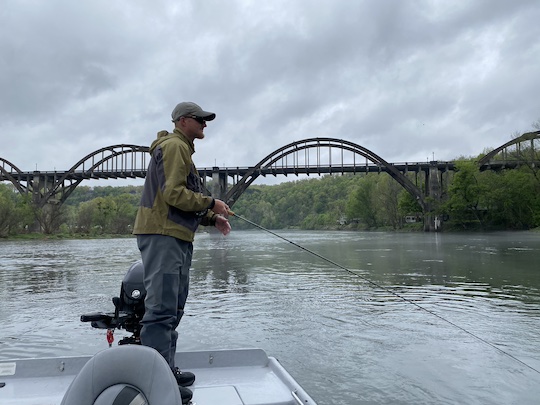 |
| Photo Courtesy of Taylor Wooten ©2024 |
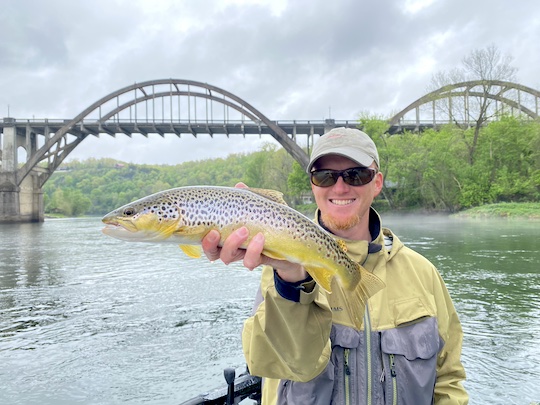 |
| Photo Courtesy of Taylor Wooten ©2024 |
That night was soggy. Our tent was soaked the next morning, but thankfully very little rain made it inside. One door had just a little bit of water under the zipper where the seal wasn't the best, but otherwise we stayed warm and dry. Our original plan had been to do some hiking that day, and then head home the next day. However, the forecast was calling for very chilly weather that next night. With lows down near 40 degrees, we knew it was going to be cold. We had already been a little on the cool side camping, but really hadn't prepared well for lows down to 40 on this particular trip.
With the sun coming out and a warm breezy day commencing, the thought of getting home a little early and having extra time to decompress and recover from our trip appealed. Once the tent dried out, we started breaking down camp and packing the car for the drive back home. We got a late start due to everything being soaked early that morning, but it was nice to get back home and start to recover from yet another excellent vacation.
I finally added another river to my list, one that I have long wanted to fish. Now I know why so many people love the White as much as they do. I'll be back as soon as possible. There are lots of other exciting possibilities on this river, from spring caddis and sulfur hatches, to late summer terrestrial fishing, to shad kill opportunities in the winter. The White River offers so much trout water and the possibility of a fish of a lifetime at any given moment. If you need a good guide for this river, I highly recommend that you check with Taylor Wooten of Flippin Fly Guides. He knows the river as well as anyone and works harder than most to put you on fish.































